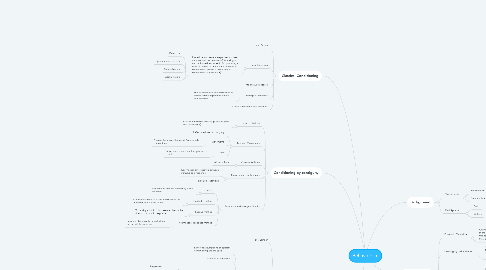
1. Classical Conditioning
1.1. Ivan Pavlov
1.2. Basic Processes
1.2.1. Procedure with several steps that involves an unconditioned stimulus (EI) causing an unconditioned response (UR), by making a stimulus linked to an action it becomes a conditioned stimulus (CS) causing a conditioned response (CR)
1.2.1.1. Extinction
1.2.1.2. Spontaneous recovery
1.2.1.3. Generalization
1.2.1.4. Discrimination
1.3. Informative variables
1.4. Biological influences
1.4.1. The response can be conditioned to certain stimuli depending on their compatibility
1.5. Conditioned emotional reactions
2. Conditioning by contiguity
2.1. Edwin R. Guthrie
2.1.1. Association-based learning principles (acts and movements)
2.2. Acts and Movements
2.2.1. Reflect the idea of contiguity
2.2.2. Movements
2.2.2.1. Discreet behaviors that result from muscle contractions
2.2.3. Acts
2.2.3.1. Large-scale movement that produce a result
2.3. Associative force
2.3.1. All or nothing
2.4. Rewards and punishments
2.4.1. Key mechanism is pairing between stimulus and response
2.4.2. Not Like Thorndike
2.5. Formation and change of habits
2.5.1. Habits
2.5.1.1. dispositions that are learned by being repeated
2.5.2. Threshold method
2.5.2.1. To modify a habit, it is presented below the threshold to avoid response
2.5.3. Fatigue method
2.5.3.1. To modify a habit, it is presented below the threshold to avoid response
2.5.4. Incompatible response method
2.5.4.1. unwanted behavior is paired with an incompatible response
3. Operant conditioning
3.1. B.F. Skinner
3.2. Conceptual Framework
3.2.1. Different assumptions of operant conditioning are analyzed
3.2.2. Scientific assumptions
3.2.3. Functional analysis of behavior
3.2.3.1. Variables
3.2.3.1.1. Dependent
3.2.3.1.2. Independent
3.2.3.2. Learning
3.2.3.3. Conditioning
3.2.3.3.1. R Type
3.2.3.3.2. E Type
3.3. Basic processes
3.3.1. Reinforcement
3.3.1.1. Responsible for the response to be strengthened
3.3.1.2. Discriminatory stimulus
3.3.1.2.1. Antecedent (A) -> Behavior (B) -> Consequence (C)
3.3.1.3. Positive reinforcement
3.3.1.4. Negative Reinforcement
3.3.1.5. Extinction
3.3.1.5.1. decreased response due to lack of reinforcement
3.3.1.6. Prmary and Secondary reinforcer
3.3.1.6.1. Primary
3.3.1.6.2. Secondary
3.3.1.6.3. Generalized reinforcer
3.3.1.7. Premack Principle
3.3.1.7.1. Order reinforcers in order to predict
3.3.1.8. Punishment
3.3.1.9. Reinforcement program
3.3.1.9.1. Continuous
3.3.1.9.2. Intermittent
3.3.1.9.3. Interval
3.3.1.9.4. Reason
3.3.1.10. Generalization
3.3.1.11. Discrimination
3.4. Behavioral change
3.4.1. Successive approximations (shaping)
3.4.2. Chaining
3.5. Behavioral Modification
3.5.1. Techniques
3.5.1.1. Backup boosters
3.5.1.2. Time out
3.5.2. Cognitive-behavioral modification
3.6. Self-regulation
4. Background
4.1. Two Schools
4.1.1. Funcionalism
4.1.2. Structuralism
4.2. First Approach
4.2.1. Pavlov
4.2.2. Watson
5. Connectionism
5.1. Edward L. Thorndike
5.1.1. Outstanding psychologist, his theory was in the first half of the twentieth century, through experiments he sought to measure the achievement of students
5.2. Learning by trial and error
5.2.1. Involving the formation of connections between sensory experiences and nervous impulses that are manifested in behavior (Repetition)
5.3. Law of exercise and effect
5.3.1. Law of exercise
5.3.1.1. It is divided into two: the law of use (it is reinforced with practice) and the law of disuse (it is eliminated without not being practiced)
5.3.2. Law of effect
5.3.2.1. Highlights the importance of consequences Satisfactory (promotes learning) Unsatisfactory (rejects)
5.4. Other principles
5.4.1. Association law
5.4.2. Law of disposition
5.4.3. Associative Change
5.4.4. Transfer
